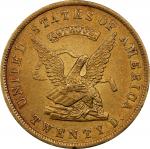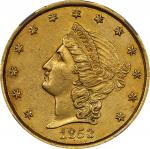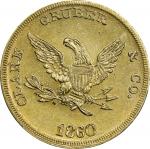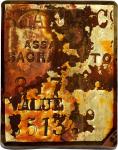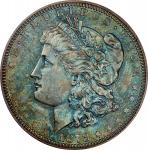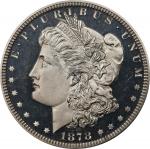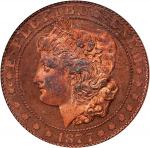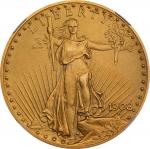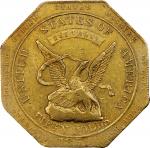1851 Augustus Humbert $50. Reeded Edge. K-6. Rarity-4. 887 THOUS., Target Reverse. AU-58 (PCGS). This is a superior coin that ranks among the finer Humbert fifty-dollar gold pieces extant. The amount of detail evident on both sides is far superior to that typically seen in survivors of this type. The rare Choice About Uncirculated level of preservation is certainly important, as most survivors are well worn. Most features are sharply impressed and crisply detailed apart from characteristic softness to the high points of the eagle and in isolated areas around the peripheries on both sides. The surfaces glow with bright, frosty, olive-orange luster that enhances already memorable eye appeal. Generally smooth, a feature rarely found on an example of this often well worn and/or heavily abraded type. There is much to recommend this coin to advanced Territorial gold specialists and we expect that this piece will find its way into either a fine Territorial gold coin cabinet or a collection focused on California Gold Rush history. In either it is destined to serve as a highlight, if not the centerpiece.<p>James Wilson Marshalls discovery of gold in Californias American River on January 24, 1848 kicked off one of the largest and most romanticized gold rushes in United States history. As news of this discovery spread, 300,000 people from the Eastern United States and abroad eventually made their way to California seeking wealth and prosperity. Some did strike it rich, although the majority bettered themselves little, either financially or otherwise. A small settlement of 200 souls in 1846, San Francisco grew into a city of 36,000 people by 1852.<p>Such a tremendous surge in population in a short period of time resulted in an acute shortage of circulating currency. Gold dust, which was quickly adopted as a medium of exchange, proved difficult and provided little more than a stopgap measure. Then there was the additional problem of what to do with all of the gold that was being mined. Clearly it needed to be converted into a form that was universally acceptable for use in California commerce and so it could be transported to major economic centers and into the nations larger economy.<p>As early as 1849, proposals were introduced both in the California Legislature and United States Congress calling for the establishment of an assay office or branch mint in California, with most Californians desiring more than simply a state-run assay office. Competing political interests delayed action on the federal governments part. To meet the immediate economic needs of Gold Rush California while final action on the part of the state and/or federal government was awaited, various private minting firms sprang up in and around San Francisco. The firm of Moffat & Co., however, became the most important private minter serving the California Gold Rush; its successors Curtis, Perry and Ward eventually sold their facility to the United States government, which reopened it as the San Francisco Mint in March 1854.<p>While still under the auspices of Moffat & Co., the firms reputation caught the eye of the federal government when the latter was finally able to take action in the establishment of a local coinage facility to service the Gold Rush. Unfortunately, however, Californians did not initially get the branch mint they desired, but instead a compromise bill passed through Congress on September 30, 1850, establishing the United States Assay Office, to be located in San Francisco. Moffat & Co. received the contract to operate as the United States Assay Office, with New York watchmaker Augustus Humbert appointed as United States Assayer. Humbert arrived in San Francisco on January 30, 1851, bringing with him the first dies for coinage that had been prepared by Charles C. Wright. The first coins - $50 gold pieces - were issued under Humberts authority the following day, with ingots following on February 14. The United States Assay Office continued to operate with these principals until the dissolution of Moffat & Co. in early 1852, after which the federal contract was assumed by Curtis, Perry & Ward under the name of the United States Assay Office of Gold. Humbert remained as assayer under the successor firm until it ceased operations on December 14, 1853.<p>Nearly a branch mint in its own right, the operations of the United States Assay Office in 1851 and 1852 represent an important and defining chapter in the coinage history of the California Gold Rush and, indeed, the nation as a whole. One of Humberts $50 gold pieces from his first year as assayer in California, this rare and beautiful coin offers an important opportunity to own one of the most impressive mementos of this widely studied and avidly collected era in United States frontier history. PCGS# 10214. NGC ID: ANH9. PCGS Population: 5; 8 finer (MS-64 finest). From Heritages sale of the Bob R. Simpson Collection, Part I, September 2020, lot 10164.

